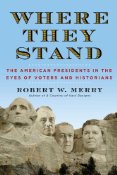
Where They Stand The American Presidents In The Eyes of Voters and Historians By Robert W. Merry
 Where They Stand
Where They Stand
The American Presidents In The Eyes of Voters and Historians
By Robert W. Merry
Where They Stand is a lively account of the game of rating the presidents, the pastime described by political scientist Clinton Rossiter (1917-1970) as “a Favorite Indoor Sport of history-minded Americans.â€Â Merry takes readers on a tour through presidential history and he is an accomplished guide.
He reminds readers of just how remarkable the invention of the office of the presidency was at the time the Constitution was written. In the age of monarchies, a chief executive who held office through the sufferance of an electorate was a new and radical idea.
By 1787, most delegates to the Constitutional Convention were persuaded that a strong national executive was necessary, but they were also mindful that tyrannical executives had been a problem throughout history. The evolution of the office is traced through the reconciliations of the disparate views of the Founders.
“Ultimately, the institution was born of two interlocking and competing imperatives that troubled the Founders, the need to curtail the whims and abuses of executive power: and the need to employ executive power to limit the whims and abuses of legislative power.†What evolved was a sharing of powers that forced the two branches to work together to govern.
Merry draws on historians’ ratings of presidents elicited in seven polls conducted between 1948 and 2005 and voters’ judgments as they hired and fired presidents through the course of American history. These two sources make up the prism through which he looks to answer the question implied in the book’s title.
The author is an optimist. He finds it encouraging that the “retrospective judgment of the historian coincides with the contemporaneous judgment of the electorate.â€
Aficionados of American democracy can take heart in this. It says that the voting collective, sifting through the complexities of the day in a highly charged electoral environment, have as much sense about the direction of the country as academics looking back with the clarity of hindsight and the cool dispassion of time.
This reviewer is not so sure that description of either electoral acumen or historians’ “cool dispassion†is accurate. Historians, like the rest of academia, tend to tilt leftward, coloring their assessments. The electorate is vulnerable to manipulation by presidents who bequeath federal largess on targeted constituencies whose votes they need.
Merry describes the emergence of “new national constituency groups beholden to (Franklin) Roosevelt’s party and thus intensely dedicated to it– workers flocking to unions under the Wagner Act, senior citizens mobilized by Social Security, farmers appreciative of agricultural subsidies, artists and intellectuals stirred by the Workers Progress Administration…This was a significant political development in America – ‘special Interests’ fostered by federal policy making–precisely the kind of development that Jefferson and Jackson had sought to prevent.†Just how this equates to electoral wisdom is puzzling.
The author is at his best when writing about the contributions of underrated Presidents Ulysses Grant and Andrew Jackson. His discussion of James Polk, whose presidency transformed America into a transcontinental power, previews A Country of Vast Designs, Merry’s excellent Polk biography.
Other than to note that Lincoln, Washington and Franklin Roosevelt are consistently ranked the top three by historians, this review won’t spoil the fun by revealing other ratings except to say that presidents elected to two terms and succeeded by members of their own party measure well. Presidents who served two terms, but were succeeded by members of the opposite party do not do so well. There are, of course, exceptions and special circumstances that are dealt with as well.
Where They Stand examines historians’ responses to the polls, ballot box judgments and what the author calls “the test of greatness;†those who met it, those who failed and the rare presidents whom he names Leaders of Destiny. A Leader of Destiny is a president able to “transform the country’s political landscape and set it upon a new course.” This reviewer rejects that criterion as a valid measure of greatness. Changing the political landscape is insufficient without regard to result. Leading the nation off a cliff does not constitute admirable leadership.
Merry sought to steer clear of such partisan judgments, but he does not always succeed. While crediting Amity Shlaes’ (The Forgotten Man) critical assessment of FDR’s failure to end the Great Depression, Merry nonetheless states “Roosevelt amassed a creditable record in getting the economy moving in the right direction and leading the country out of the slough of despair.â€Â This is a difficult statement to justify given that after six years of rapacious New Deal spending the country remained economically despondent and the 1938 unemployment rate was 17.4 percent.
This reviewer’s carping aside, Where They Stand is worth the time of anyone interested in the men who occupied (and occupy) the highest office the electorate can confer. Merry is a serious writer but one who obviously enjoyed playing the rating game. Readers will find that they share that enjoyment.
 The posts are coming!
The posts are coming!

0 comments
Kick things off by filling out the form below.
Leave a Comment